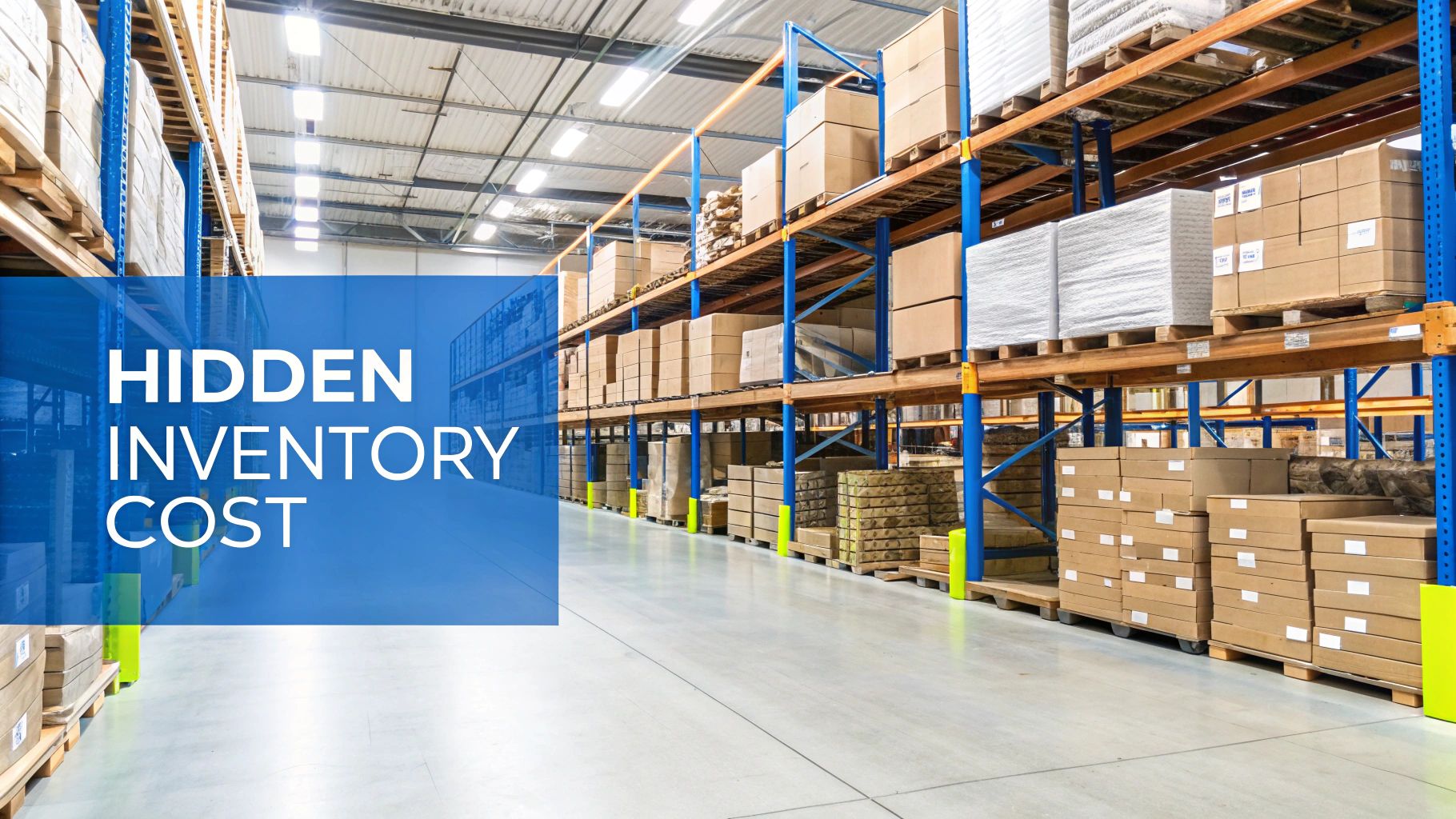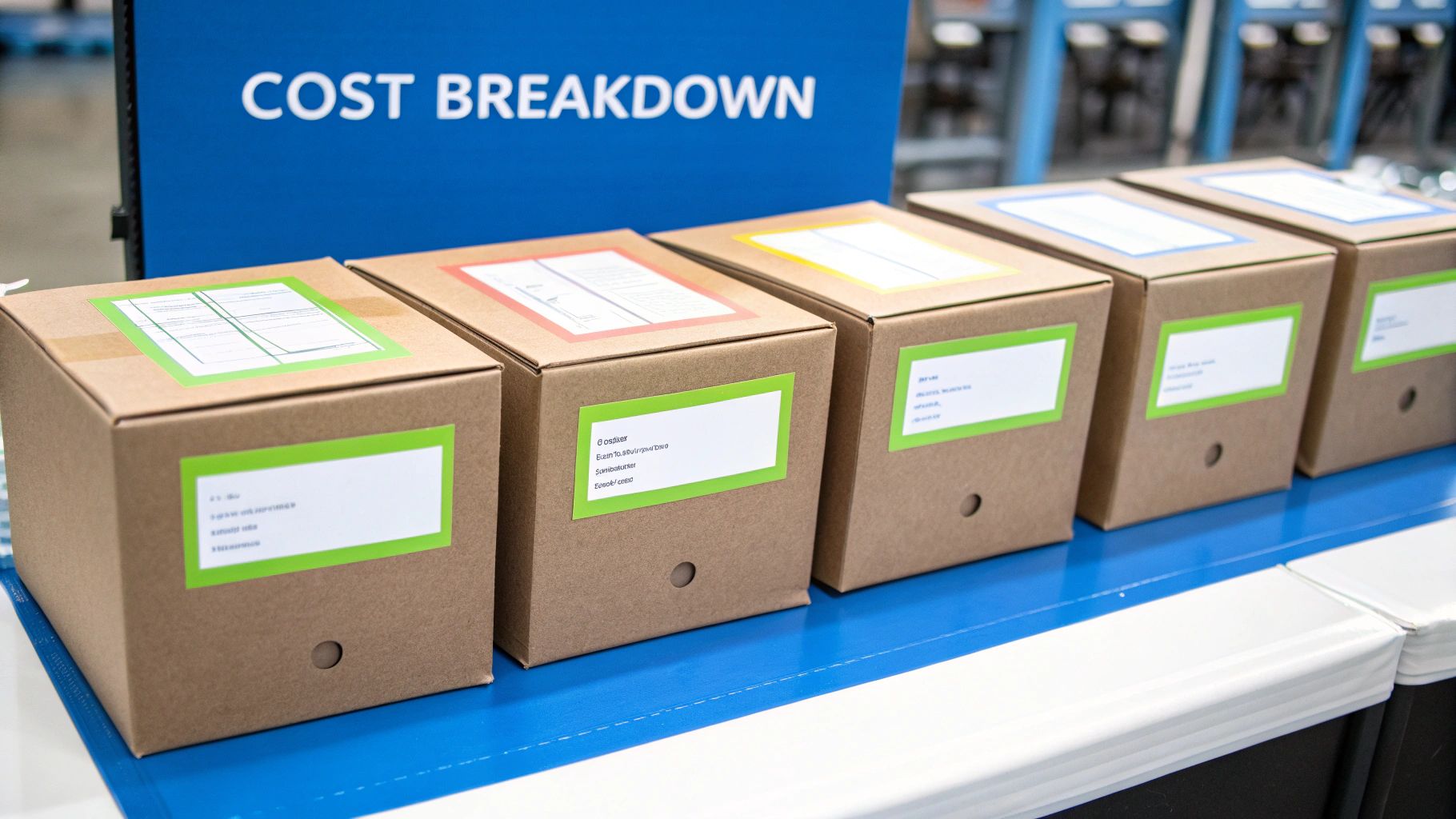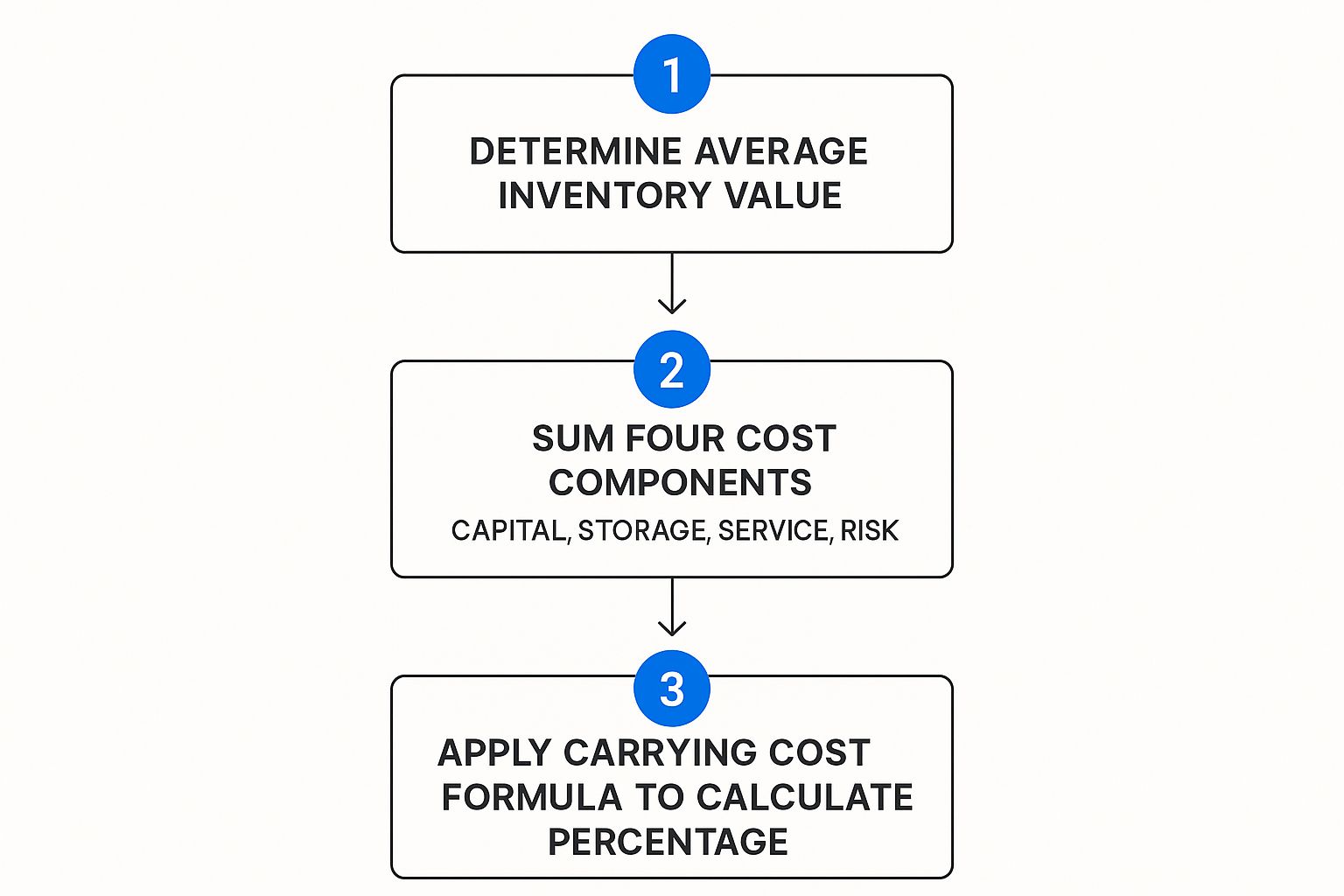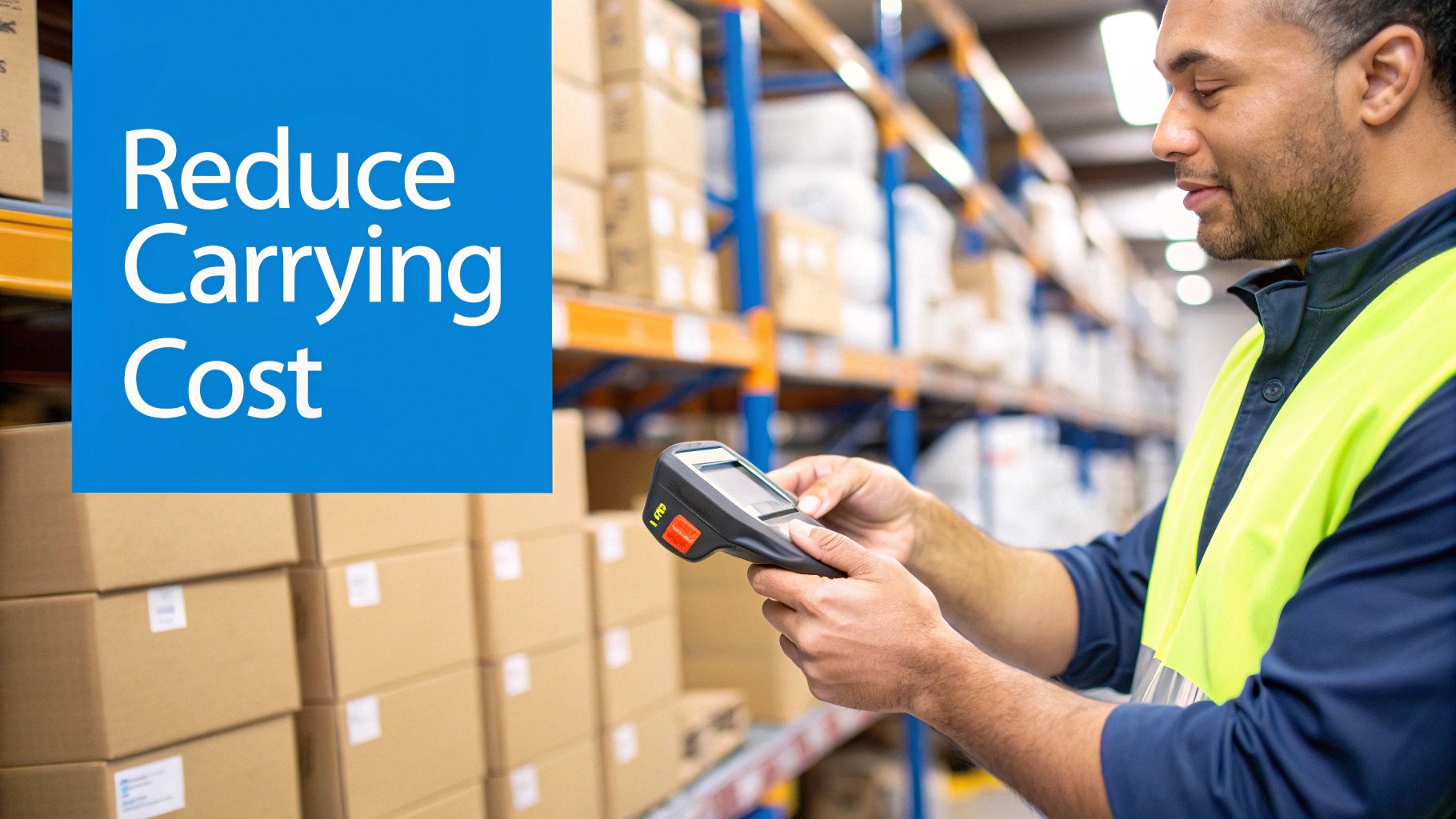To figure out your inventory carrying cost, you’re basically summing up all the expenses that come from holding unsold stock and then expressing that number as a percentage of your total inventory's value.
The formula looks like this: Carrying Cost % = (Inventory Holding Sum / Total Inventory Value) x 100. This one number pulls back the curtain on the hidden expenses that are quietly eating away at your profits.

That unsold product sitting on your warehouse shelf represents so much more than what you paid for it. It's an active drain on your bottom line, racking up hidden expenses every single day it stays put. Getting a handle on how to calculate your inventory carrying costs is the crucial first step toward plugging these financial leaks.
This figure, often called holding cost, is the grand total of every expense tied to storing your inventory before it finds a home with a customer. It's not just about the monthly rent for your warehouse space. We're talking about a bundle of four distinct cost categories that every business owner needs to get a handle on.
Without a clear picture of these expenses, you might jump on a bulk purchase discount thinking it's a great deal, only to realize later that the prolonged storage costs completely wiped out any savings. It happens more often than you'd think.
To get a truly accurate calculation, you need to pull together the expenses from four key areas. Think of these as the pillars that hold up your total holding costs. Getting them right is critical for an honest financial overview.
To help you visualize what goes into this calculation, we've broken down these four pillars into their core components.
By adding up the expenses from these four areas, you create a complete and accurate picture of what it truly costs to hold your inventory.
Summing these four components gives you a comprehensive view of your holding expenses. Supply chain experts often find these costs can represent a shockingly large slice of a company's total operational budget. You can dive deeper into how these costs break down in our guide on the fundamentals of carrying costs.
Ultimately, inventory carrying costs represent a significant chunk of your total supply chain expenses. Calculating this percentage gives you a clear, simple metric to manage and optimize how you handle your stock. Of course, a solid grasp of basic accounting principles is the foundation for getting these complex figures right in the first place.

To really get a grip on your inventory carrying costs, you can't just look at one big, scary number. The total cost is actually a mashup of four distinct categories, and each one tells a part of the story about where your money is going while products sit on the shelf.
Think of it like a detective investigating a case. A vague conclusion won't cut it; you need to find the specific clues that lead you to the source of the problem. We’re going to break down each of these four cost pillars—Capital, Storage Space, Service, and Risk—to uncover the hidden expenses that are likely eating into your profits.
This is usually the biggest piece of the pie and the one with the most financial sting. Capital costs are all about the money you've invested in your inventory—money that, as a result, can't be used for anything else. It's not just what you paid for the goods; it’s the financial ripple effect of having that cash locked away.
The most straightforward part of this is any interest you're paying on loans used to buy that inventory. If you borrowed $50,000 to bring in a new product line, the interest payments on that loan are a direct capital cost. Simple enough.
But the real kicker, and the part that often gets missed, is the opportunity cost. This is the potential return you could have earned if that cash wasn't tied up in physical stock. That same $50,000 could have been fueling a new marketing campaign, upgrading equipment, or even just earning interest in a high-yield savings account. Those potential gains are gone, and that loss is a very real cost to your business.
Opportunity cost is the silent profit killer in inventory management. By holding excess stock, you're not just paying for shelf space; you're forfeiting the chance to invest in growth-driving activities that could deliver a much higher return.
When people hear "storage costs," their minds immediately jump to the monthly rent or mortgage payment for the warehouse. While that's a big chunk, it’s only the tip of the iceberg. True storage space costs cover every single expense related to the physical housing of your products.
These expenses are a mix of fixed and variable costs that can add up shockingly fast. You've got to account for things like:
Each of these pieces contributes to the total cost of keeping your products safe, sound, and ready to ship. Ignoring them means you're seriously underestimating your true carrying costs.
This bucket holds all the operational expenses needed to actually manage, handle, and protect your inventory. Think of these as the "service fees" for keeping your stock organized, accounted for, and insured. They are absolutely essential for smooth operations but are often scattered across different budget lines.
Insurance premiums are a huge one here. You need policies to cover your inventory against disasters like fire, flood, or major damage. And, of course, the higher the value of your inventory, the higher your insurance bill will be.
Another key service cost is the technology that runs the show. Those recurring subscription fees for your Inventory Management System (IMS) or Warehouse Management System (WMS) are a constant expense. These systems are the backbone of your operation, but they aren't free. Finally, remember to include property taxes on your warehouse, which are directly tied to the space your inventory occupies. For a deeper dive into how your accounting methods affect these numbers, check out our guide to help you master inventory valuation methods for better accounting.
The final component covers the very real possibility that your inventory will lose value for reasons totally outside of your control. These risks are just part of the game when you hold physical goods, and the costs can be devastating if you haven't planned for them.
The main risks you need to watch out for are:
These risks show just how volatile holding inventory can be. External market conditions play a massive role. In recent years, U.S. inventory carrying costs shot up to $302 billion, a 13.2% increase, as companies started holding more safety stock to guard against supply chain chaos. At the same time, warehousing costs jumped by about 7% thanks to a shortage of space and rising rents, proving how outside pressures can directly inflate these risk and storage costs.
To help you get started, we've put together a checklist to make sure you don't miss any of the specific costs that fall under these four pillars. Use this table to brainstorm and categorize every expense related to holding your inventory.
By systematically working through this list, you can build a far more accurate and comprehensive picture of your true carrying costs, which is the first step toward bringing them under control.
Knowing the theory behind carrying costs is one thing, but actually crunching the numbers is where it all starts to click. Let's walk through the formula with a couple of real-world business scenarios to see how this plays out in practice. This is how you'll move from just understanding the concept to actually calculating it for your own operation.
This flow chart gives you a bird's-eye view of the calculation, breaking it down into three straightforward parts.

As you can see, it really just comes down to gathering your cost data and plugging it into the formula to find your carrying cost percentage.
Let's start small. Imagine an e-commerce coffee business, "Morning Grind," that wants to figure out the carrying cost for its most popular product line—a single-origin Ethiopian bean. They need to know if their current order size is truly profitable.
First up, they need their average inventory value. Over the last year, they started with $8,000 worth of these beans and ended the year with $6,000.
The math is simple: ($8,000 + $6,000) / 2 = $7,000.
Next, they'll tally up all the holding costs tied to this specific coffee for the year.
Now, we just add those costs up to get the Inventory Holding Sum:
$560 (Capital) + $400 (Storage) + $250 (Service) + $200 (Risk) = $1,410
Finally, they can plug everything into the carrying cost formula:
(Inventory Holding Sum / Average Inventory Value) x 100
($1,410 / $7,000) x 100 = 20.14%
For Morning Grind, the carrying cost for their best-selling beans is 20.14%. This tells them that for every dollar's worth of Ethiopian coffee sitting on their shelves, it costs them just over 20 cents a year to keep it there. That number is a crucial baseline for making smarter purchasing decisions.
Now let's scale things up with "Volt Distribution," a company supplying electronic components to retailers. They need to calculate the carrying cost for their entire inventory to find ways to optimize their supply chain.
Their beginning inventory value was $2,500,000, and they ended the fiscal year with $2,100,000. This gives them an average inventory value of ($2,500,000 + $2,100,000) / 2 = $2,300,000.
Next, they have to round up all their annual holding costs.
With those numbers ready, Volt Distribution can calculate their Inventory Holding Sum:
$325,000 (Capital) + $180,000 (Storage) + $80,000 (Service) + $75,000 (Risk) = $660,000
And finally, they get their carrying cost percentage:
($660,000 / $2,300,000) x 100 = 28.7%
Volt Distribution’s carrying cost is a whopping 28.7%. This is a major red flag, showing that nearly a third of their inventory's value is being eaten up by holding costs every year. It’s a clear sign they need to improve inventory turnover and reduce how long products sit on the shelf.
This kind of data is powerful. It’s exactly why understanding metrics like this is so important, as you can learn more by exploring your guide to Days on Hand inventory calculation. This one number gives their leadership team a compelling reason to invest in better forecasting and more efficient warehouse management.
Figuring out your inventory carrying cost is so much more than an accounting chore. This single percentage gives you a direct, unfiltered look into the health of your supply chain. It tells you exactly how much cash is getting eaten up just by letting products sit on your shelves.
When that number creeps up, it's a huge warning sign. It’s pointing to bigger operational problems that need your attention, right now. A carrying cost of 25% or higher is a classic signal of inefficiencies in purchasing, forecasting, or even how your warehouse is organized. It forces you to ask some tough, but necessary, questions.
Don't just calculate this number once and file it away. Think of it as a vital diagnostic tool that helps you make smarter, more profitable decisions across the board. It turns those fuzzy, abstract costs into a real number you can actually manage and drive down.
One of the first places you'll feel the impact is in your purchasing decisions.
Imagine a supplier dangles a 10% discount on a massive bulk order. On the surface, it’s a no-brainer. But if your carrying cost is 25%, the expense of holding all that extra inventory for months could completely erase those savings. In fact, it could end up costing you more in the long run.
This is the hard data you need to weigh a volume discount against the very real costs of storage and risk.
Armed with your carrying cost percentage, you can confidently decide whether to accept bulk deals. It’s no longer a gut feeling; it’s a data-driven choice that protects your cash flow and maximizes profitability.
The same logic applies directly to your pricing strategy. If it costs you a lot to hold a certain product, that expense has to be baked into its sale price to protect your margins. Ignoring carrying costs is a fast track to underpricing your items—especially the slow-movers—and accidentally selling them at a loss.
A high carrying cost is almost always a symptom of a deeper issue. It’s a red flag that can guide you to specific areas begging for improvement. For example, consistently high holding costs often shine a light on:
This whole calculation has gotten even more complicated in today's messy supply chain environment. For instance, the lead time for shipments from China to the U.S. has jumped by roughly 50% since 2019. That reality forces businesses to hold more safety stock, which ties up more capital and pushes carrying costs higher.
By getting a handle on what's driving your carrying costs, you can shift from just holding inventory to actively managing it. That's a fundamental move for any growing e-commerce brand. A huge piece of that puzzle is understanding the benefits of maintaining low inventory levels for your online store, which gets right to the root cause of high carrying costs.

Alright, you've done the hard work of calculating your inventory carrying cost. That percentage isn't just a number on a spreadsheet; it's a baseline, a starting point for making your business more profitable.
The goal now is to shrink that number. Every fraction of a percentage you shave off translates directly into better cash flow and healthier margins. These aren't just abstract theories—they're field-tested strategies that get right to the root of bloated inventory expenses. Let's dig into a few of the most effective ways to make a real dent in your holding costs.
One of the most powerful moves you can make is to simply hold less inventory. That's the entire philosophy behind lean models like Just-in-Time (JIT). Instead of tying up cash in massive stock orders that collect dust for months, JIT is all about receiving goods from suppliers precisely when you need them for production or to ship to a customer.
This approach immediately slashes your storage costs and frees up capital that was otherwise trapped in unsold products. It also dramatically cuts your risk of obsolescence and shrinkage, since products spend far less time sitting on your shelves.
Of course, making JIT work requires incredible coordination and trust with your suppliers. You need partners who are rock-solid reliable. It's not a switch you can flip overnight, but the potential payoff is huge.
Guessing games are expensive. Inaccurate forecasting is a huge driver of high carrying costs, because overestimating demand means you’re overstocking. That inflates every single one of the four cost components we talked about.
This is where modern inventory management software has become a total game-changer. These systems don't just look at last month's sales; they analyze historical data, market trends, and even use machine learning to predict future demand with startling accuracy. This lets you order the right amount of stock at the right time, avoiding the costly mistake of having cash tied up in products that just aren't moving.
A study by Gartner predicted that major retailers could cut their inventory carrying costs by as much as 30% through improved forecasting and management. This highlights the direct link between accurate predictions and a healthier balance sheet.
To really nail this, you should look for software with advanced inventory management features. The best tools can automate your reorder points and serve up the data-driven insights you need to make smarter purchasing decisions.
How you organize your warehouse isn't just about tidiness—it directly impacts your storage and service costs. A disorganized, inefficient layout means your team spends more time and labor picking, packing, and shipping orders. It can even lead to more product damage.
A great place to start is with a product velocity analysis. The classic method here is ABC analysis, which buckets your inventory:
It sounds simple, but placing your "A" items in the most accessible spots near your packing stations can radically cut down on travel time for your staff. This one change cuts labor costs and speeds up fulfillment. A smarter layout also helps you use vertical space more effectively, which could even mean you can operate in a smaller, less expensive facility.
Don't underestimate the power of a good relationship with your suppliers. They can be a key lever for reducing costs. Get on the phone and negotiate better terms. This could mean more favorable payment schedules that improve your cash flow or shorter lead times that let you trim down your safety stock.
On the internal front, automation is your best friend. Simple tools like barcode scanners, paired with a solid inventory management system, can all but eliminate the clerical errors that lead to shrinkage. When you have real-time visibility into your stock levels, you also cut way down on the labor hours spent on tedious manual cycle counts.
By focusing on these areas—lean principles, sharp forecasting, a smart warehouse layout, and strong partnerships—you can systematically chip away at your inventory carrying costs. It's an ongoing process, but every small improvement adds up and flows directly to your bottom line.
Once you start digging into the numbers, a few questions always seem to pop up. Nailing the calculation is one thing, but understanding the nuances is where you find the real strategic wins. Let's run through some of the most common things business owners ask when they get into the weeds with this metric.
This is the million-dollar question, and the honest-to-goodness answer is: it depends. There’s no magic number that fits every business. What’s considered “good” is completely tied to your industry and the kind of products you’re selling.
As a general rule of thumb, the accepted benchmark across most industries floats between 20% and 30% of your inventory's total value. But this can swing wildly depending on what's on your shelves.
The real goal isn't to hit some generic industry average. It's to figure out your own baseline and then find ways to consistently bring it down. Shaving off even 2% from your carrying costs can make a noticeable difference to your net profit.
Calculating your inventory carrying cost shouldn't be a one-and-done task you check off a to-do list. For it to be a genuinely useful tool, it needs to be a regular part of your financial check-ups. How often you do it really comes down to the rhythm of your business and how quickly your inventory turns over.
For most e-commerce businesses, a quarterly calculation is a solid place to start. It gives you a timely snapshot that helps you spot trends before a small leak becomes a major drain on your finances.
But if you’re in a fast-moving industry or deal with a lot of seasonal products, you might want to run the numbers monthly. This gives you the agility to tweak your purchasing and marketing on the fly, stopping you from getting stuck with a mountain of costly, out-of-season stock. An annual calculation is the absolute bare minimum, but frankly, it often means you're looking at problems that are already a year old.
In a word: no. As long as you hold physical inventory, a carrying cost of zero is pretty much impossible. The second you buy that stock, you start racking up costs.
Think about it. Even if you owned your warehouse outright and didn't pay a dime in rent, you'd still have capital tied up in that inventory. You'd still need insurance to cover it, you'd still face the risk of damage or theft, and you'd still have to pay for the lights, software, and people needed to manage it all.
Every one of the four core components—capital, storage, service, and risk—will always have a value greater than zero for any business holding physical goods. The goal isn't to hit zero, but to manage and shrink those costs as efficiently as you possibly can.
Ready to stop letting hidden costs eat into your profits? At Simpl Fulfillment, we handle the complexities of warehousing, inventory management, and order fulfillment so you can focus on growing your brand. Discover how our streamlined 3PL services can significantly reduce your inventory carrying costs and improve your bottom line. Learn more about how Simpl Fulfillment can optimize your logistics today.